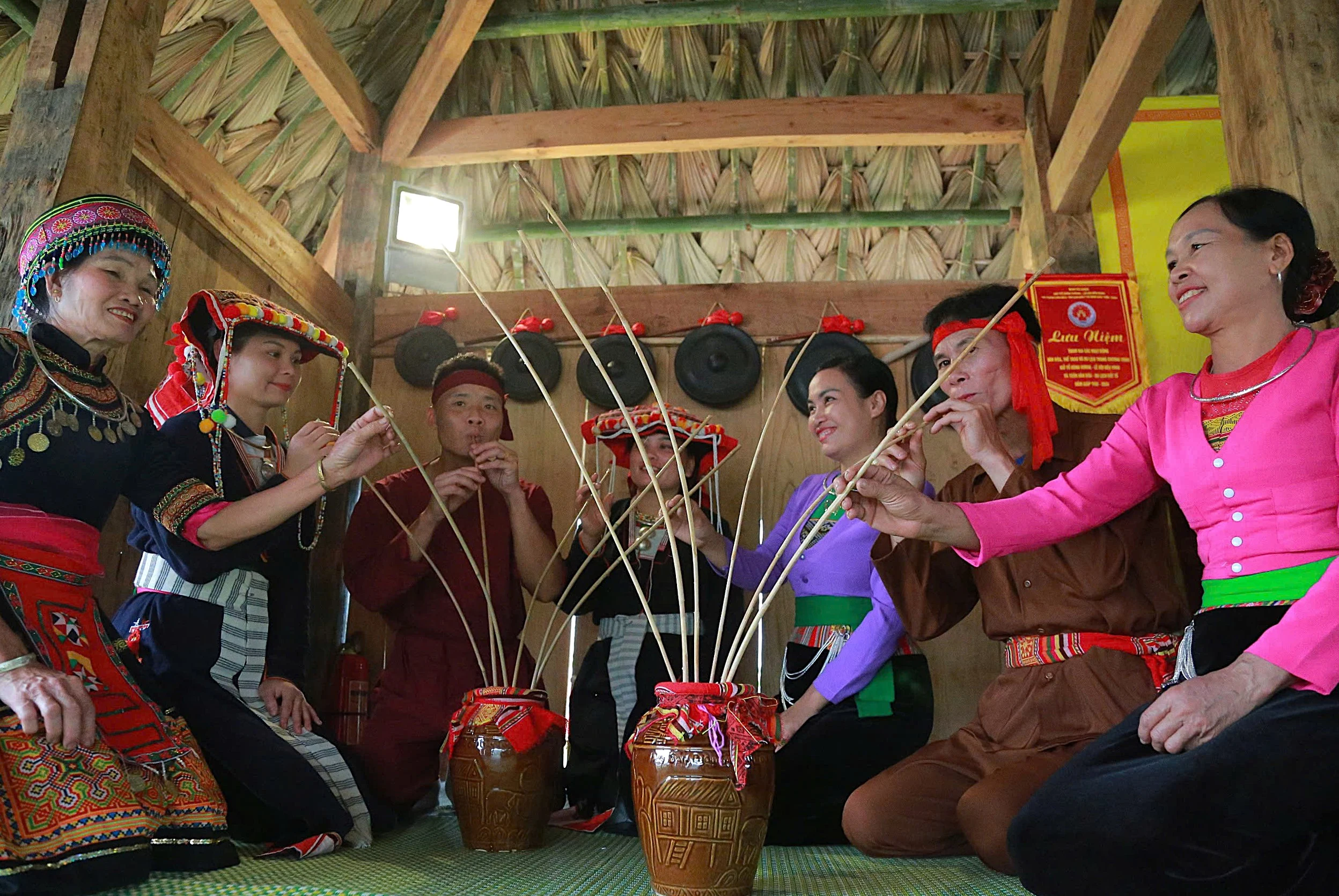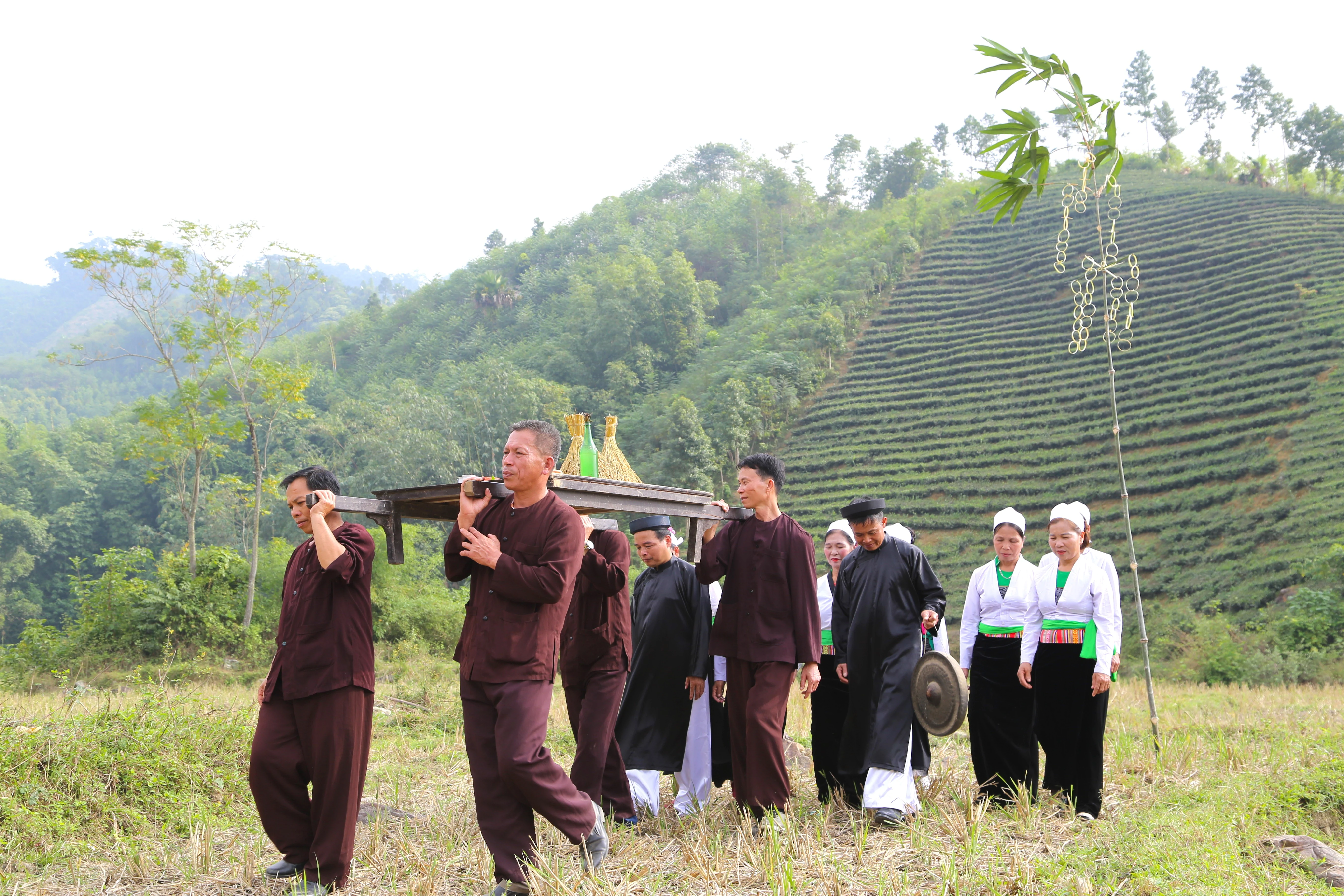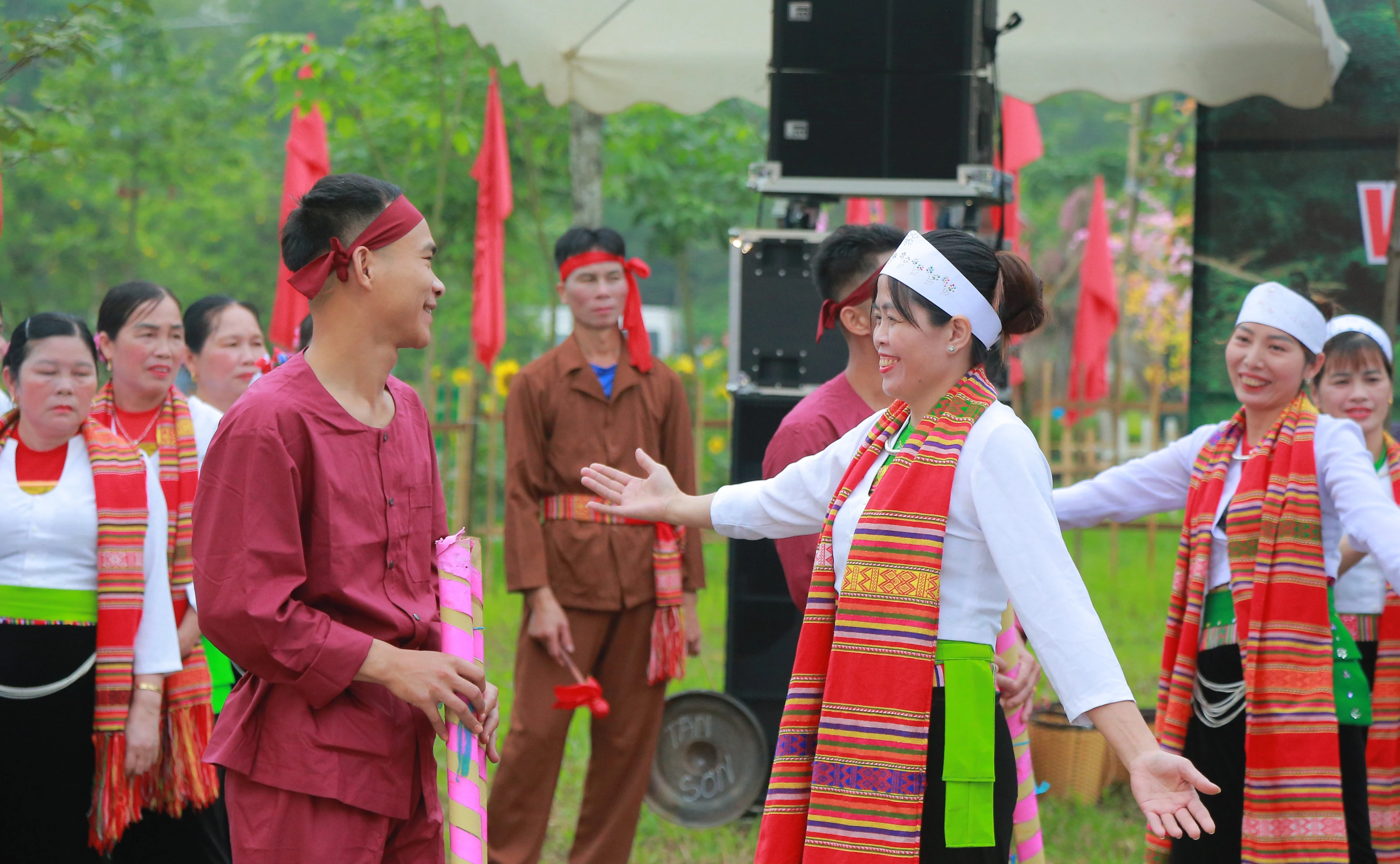{title}
{publish}
{head}
Welcoming Tet in spring is a cherished tradition of the Vietnamese people. Among Vietnam’s ethnic groups, although Tet customs and rituals vary, they all share the same joy and hope for a new year filled with warmth, peace, happiness, and prosperity. For the Muong people of Tan Son district, Tet is also a time-honored tradition, a rich cultural heritage that reflects their deep sense of community and cultural identity. For the Muong people, Tet is not only a time to celebrate spring but also an occasion for cultural reunions and strengthening community bonds.

Can wine is a traditional Tet delicacy of the Muong people in Tan Son district.
On the last night of the lunar year, the small Chieng village (an original Muong village, now in zone 5, Kiet Son commune) remains covered in thick fog. From the traditional stilt houses, the resonant sounds of the gongs reverberate across the mountains and forests. A few minutes later, the yard of the village’s community cultural house is packed with people. Dressed in traditional costumes, people of all ages walk around the village. They played traditional Muong musical instruments and sang in their native language, calling upon heaven and earth to bear witness to the festival as the village welcomed Tet and embraced the arrival of spring.
This is an important ritual in Muong Tet customs in Tan Son district. Only when the gong strikes three times, echoing throughout the village, does the Muong community officially enter the new year, and other Tet rituals commence.

The Muong people of Thu Cuc commune, Tan Son district, observe the tradition of carrying the spirit of rice to the fields as part of their festival rituals.
Like many other ethnic groups, the Muong people of Tan Son celebrate Tet as one of their most important festivals of the year. Therefore, long before Tet, the Muong people raise pigs and chickens, select the best sticky rice and green beans, and set aside ingredients to prepare traditional dishes. They also make two or three jars of rice wine to serve guests, following the traditional customs of "cooked rice, stilt houses, water on a shoulder pole, roasted pigs."
Mo Muong artisan Ha Van Quang (zone 5, Kiet Son commune) said, "For the Muong people, the ancestral worship ceremony is the most important ritual of Tet." During these days, the Muong altar must include a tray of five fruits, along with two sugarcanes placed on either side. These symbolize canes for the ancestors to lean on as they return to their descendants, guiding their spirits from heaven to earth. The Muong believe that offerings should reflect the food people eat, so the offering tray includes a variety of Tet dishes such as boiled chicken, traditional cakes like tube cakes, small cakes, croissants, and love cakes, as well as corn wine, sticky rice, boiled meat, grilled fish, betel and areca nuts, and fish sauce. Each family observing the ancestral worship tradition prepares an equivalent amount of cakes and meat as offerings, demonstrating filial piety and remembrance of their ancestors. As part of the Muong people’s Tet traditions, in addition to ancestral worship and beating gongs to open the festival, unique customs such as New Year greetings, house-entering rituals, and wine offerings are also observed. As a sign of respect for filial piety and gratitude, the first guests in Muong villages are typically received by the families of village elders and shamans. While sharing a jar of wine, the host invites guests to exchange wishes, which are conveyed through the soulful and profound melodies of Vi and Rang songs. In some Muong villages in the district today, the tradition of singing and reciting traditional chants during Tet is still preserved and passed down by local people. Accordingly, a group of about 12 Muong villagers, regardless of age or gender, who know how to play gongs and sing, will gather to form a traditional singing troupe. On the last night of December, known as the “nine mortars in March” night, they awaken the gongs, then go from house to house, beating the gongs in rhythm and singing. The Muong people believe that the deep, echoing sound of the gongs, combined with joyful and sincere festive songs, heralds a prosperous and lucky new year.

Tet is an opportunity for the Muong people in Tan Son district to engage in cultural exchange and strengthen community solidarity.

Tet Nam Moi is the biggest festival of the year for the Muong people in Tan Son district. Tet begins on the 27th day of the 12th lunar month and ends on the 7th day of the 1st lunar month. From December 27 to 30, the Muong people carry out various tasks such as sweeping graves, planting poles, cleaning houses, and washing production tools. This tradition symbolizes the purification of their surroundings to welcome the new year with hopes of prosperity and peace. Tet officially concludes on January 7, marking the transition into a new season. On this day, the Muong people organize a festival known as the rice spirit procession, during which they pray for a year of bountiful harvests, peace, and prosperity. After this day, Tet officially ends, and the Muong people return to the fields to plow and plant the first rice crop of the year.
Tet in Muong villages is an occasion for villagers to gather, for men and women to meet, make friends, and socialize, fostering a strong sense of community and cultural exchange. Therefore, during the main days of Tet, the Muong people organize vibrant cultural, sports, and entertainment activities that showcase their unique heritage. People of all ages, both men and women, dress in their finest attire to attend the festival and celebrate the arrival of spring. The joyful, bustling atmosphere of spring fills the Muong villages.
As a mountainous district with a population of Muong ethnic people accounting for over 70% of the population, in recent years, in order to preserve and promote the good traditional values in the traditional New Year customs of the Muong people, the People’s Committee of Tan Son district has developed a plan and directed the district’s Department of Culture and Information to guide the communes in the area to organize a variety of cultural exchange activities to celebrate the Party and Spring, associated with preserving and promoting the beauty of the traditional New Year culture of ethnic minorities in the area in general and the Muong people in particular. Notable examples include organizing the festival of going to the fields (associated with the custom of carrying the rice spirit) in Thu Cuc commune and the festival of the Holy Temple in Thach Kiet commune; Organize cultural exchange, sports, and entertainment activities with Muong ethnic identity (such as Vi singing, Rang singing, Sinh Tien dancing, gong playing, Cham Duong, crossbow shooting, throwing con, swinging, etc.).
In January, the warm sunshine fills every stilt house with the fresh air of spring. Amidst the warmth of wine and the resounding gongs, the Muong village comes alive with joyful spring songs. More than just a festival, preserving and promoting the beauty of traditional Tet is how the Muong people keep their cultural heritage alive.
Bich Ngoc

In recent years, the Department of Culture, Sports and Tourism of Phu Tho Province has paid close attention to the conservation and promotion of cultural heritage values.

baophutho.vn For the Muong people in Hoa Binh, gongs are not only musical instruments, but also a “sacred soul treasure” accompanying them from birth until...

baophutho.vn The Ministry of Culture, Sports and Tourism has officially announced the updated List of National Intangible Cultural Heritages. Following the...

baophutho.vn Set against the rich cultural backdrop of the mountains and forests, the cuisine of the Muong ethnic group has become an essential element in...

baophutho.vn On the morning of July 30, at Thuong Temple on Nghia Linh mountain within the Hung King Temple Historical Site, a delegation from the...

baophutho.vn Following the reorganization of commune-level administrative units, the Muong Vang region, formerly part of Lac Son district, was restructured...

baophutho.vn On the quiet Hill 79 in Hoa Binh Ward, nestled in the heart of the city along the Da River, lies a memory zone that quietly preserves the...

baophutho.vn The traditional art of creating skirt patterns among the Muong people, originally in Hoa Binh province, now part of Phu Tho province, has been...

baophutho.vn The Ministry of Culture, Sports, and Tourism has officially released the latest List of National Intangible Cultural Heritages, with the newly...

baophutho.vn The project to merge the three provinces of Phu Tho, Vinh Phuc, and Hoa Binh into a new Phu Tho province places high demands on solidarity and...

baophutho.vn In the early days of the new year, it is easy to see women and even children wearing Ao Dai as they stroll through the streets celebrating Tet....

baophutho.vn During festive occasions and the Lunar New Year, Muong women in Tu Vu Commune, Thanh Thuy District, diligently prepare ingredients to make fish...